A lack of skills, but also a lack of solutions
I often roll my eyes at articles that take millennials to task for not measuring up to the standard of the day. All too often, baby boomers and those in generations before seem to wag their fingers at young people and spew out curmudgeonly laments that inevitably start with, “When I was your age …”
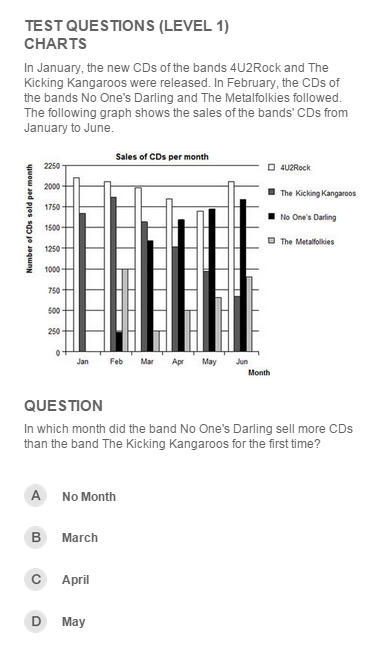
As I dug into a new report by the Educational Testing Service (There was a link, but the page no longer exists), though, I began to buy into the concerns it raises about the skills of American millennials when compared with those of their counterparts worldwide. (ETS creates the GRE and TOEFL tests, among others.) The new report, written by Madeline J. Goodman, Anita M. Sands, and Richard J. Coley, is called “America’s Skills Challenge: Millennials and the Future.”
Across the board, data from the study suggest that Americans rank near the bottom in literacy, numeracy, and problem-solving in technology-rich environments (things like using digital maps and calculating the price of tickets from a kiosk). This holds true for high school graduates and for those with bachelor’s and master’s degrees.
“A decade ago, the skill level of American adults was judged ‘mediocre,’” the authors write. “Now it is below even that.”
More education, fewer skills
The 82 million American millennials – those born after 1980 – have received more formal education than any previous generation, the authors write, yet their demonstration of skills in literacy and numeracy are middling at best. The U.S. is the wealthiest among 22 nations where the test was administered, but it is also “the most economically unequal.”
Given the poor performance of American millennials on these tests, the report says, we should “consider critically the value that higher education in the U.S. is contributing to the skills of our young adults,” adding: “For education to be a vehicle to future success, for it to fuel the American Dream, it has to be aligned with an economy that values the skills it imparts, and those skills must be translatable to tangible opportunities.”
One of the most interesting – and ominous – assertions the report makes is that the growing economic inequality in American society today is very likely to compound the disparity in skills. Students whose parents hold college degrees generally have greater skills in literacy and math than those whose parents have only high school diplomas. As the cost of college rises and economic inequality grows, those at the top will have great access to education and the opportunities it brings while those at the bottom will have fewer opportunities.
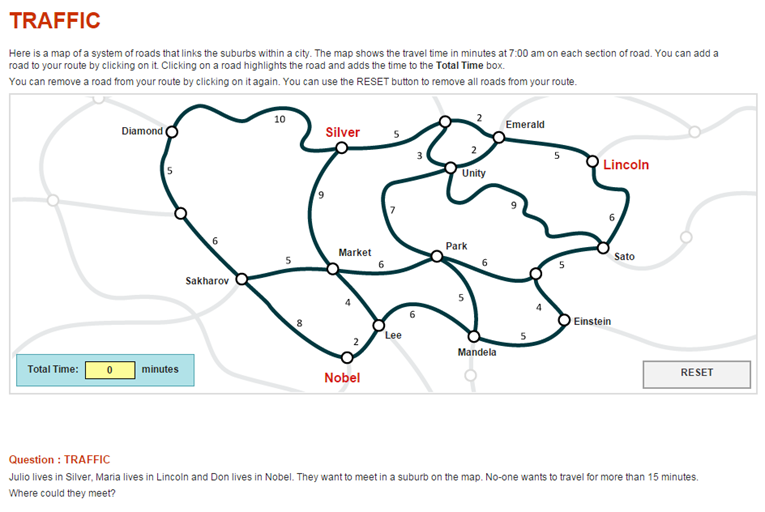
“A very real danger lies in perpetuating a cycle where low skill levels, less income, and less access to quality education will beget a further entrenchment of deep inequality, with some segments of society more at risk than others,” the authors write.” This is the very opposite of what a meritocratic society purports to offer.”
For instance, scores of blacks and Hispanics were 15 to 24 percent below those of their white counterparts, depending upon the age group. As the report explains, though, whites and Asian-Americans still scored below the average for all those who took the tests internationally.
What can we do?
Tests of all kinds tend to do a much better job of measuring students’ ability to take tests than they do in measuring their ability to apply skills in a realistic setting. I’m also suspicious of “the sky is falling” reports about education. The sky has been falling since at least the 1970s. As I said earlier, though, I’ve had trouble finding fault with this study.
Perhaps the main weakness in the study is its lack of solutions. It makes a strong case that the skills of American millennials rank below those of their international counterparts. It doesn’t explain why or how to fix the problem, though. Here are some obvious ones:
De-emphasize standardized testing. Instead of fixating on standardized testing, give teachers the freedom to help students learn in meaningful ways. Many are doing that already with blended learning, project-based learning, team-based learning, and other methods. Until schools adopt a teacher evaluation system that uses standardized tests as a small part of a much larger portfolio, teachers will focus on test scores.
Make skills matter. Today’s academic culture promotes the idea of education as a product rather than a process of learning. Reversing that will require more meaningful demonstrations of skills over grades and a diploma. And until universities stop basing admissions decisions on standardized test scores, the ability to take those tests will matter far more than than more meaningful skills.
Emphasize active learning. As Maryellen Weimer writes in Faculty Focus (There was a link, but the page no longer exists): “We can’t seem to disavow ourselves of the notion that teachers should do most of the talking.” Active learning helps students gain crucial skills. Wide-scale of adoption of active learning is unlikely occur, though, until instructors are rewarded for taking risks.
Value teaching. Higher education still lacks a meaningful reward system for high-quality teaching. Until we change that, teaching will play a diminished role that results in diminished skills for students.
The problem is far more complex than any of those solutions, but those areas can at least provide an entry into a much-needed and, as the ETS report emphasizes, increasingly urgent problem.
Briefly …
Jonathan Rees, a professor of history at Colorado State, Pueblo, says that the university tenure system “is on life support” but deserves to be saved because it “is the best form of quality control that higher education has.” … The UK is struggling to recruit and retain teachers, investment in education has dropped, and student skills lag, The Guardian reports, saying, “Education has never mattered more, so why won’t the UK invest in it properly?” … Educause has joined other organizations in expressing concern about the discriminatory aspects of Indiana’s Religious Freedom Information Act. In an email message, the organization’s president and CEO, Diana Oblinger, said Educause had been looking for alternative sites to Indianapolis for its October conference and had written a letter to Indiana’s governor. … Three white papers issued by the U.S. Senate “show that lawmakers are considering significant changes in the ways colleges are evaluated and held accountable for student outcomes,” The Chronicle of Higher Education reports.
How to improve teaching? Change the rewards system.
Faculty often see the benefits of online education for students but not for themselves, Karen H. Sibley and Ren Whitaker write in Educause.
Development of online courses takes precious time away from other activities that generate greater rewards for faculty. The way to change that, Sibley and Whitaker argue, is to offer incentives to move into online education. They give these examples:
- Providing compensation as salary, research funds, or time (e.g., a course buy-out)
- Appealing to a sense of curiosity and a desire to develop new skills for those attracted to experimental work or invigorated by the chance to reimagine their courses
- Delivering training and support to lower the barriers and to decrease the time and effort needed to develop or adapt new instructional approaches
- Activating a sense of mission and loyalty to their students and the institution
- Increasing a sense of relevance for those who want to remain current in the rapidly changing environment of higher education
- Recognizing effective engagement in online learning in the institutional reward systems
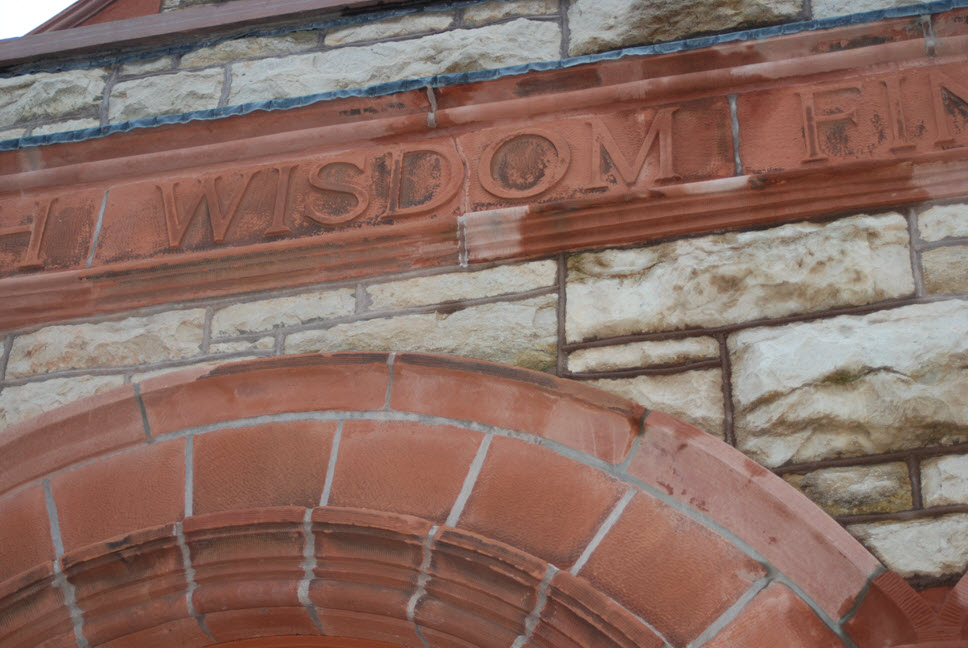
Online education is really just one example of a much larger problem in the way higher education values (or doesn’t value) innovative and reflective teaching and learning. Sibley and Whitaker offer good steps to promote change. Ultimately, though, two enormous cultural barriers stand in the way.
First, attitudes about the value of teaching must change. Many faculty members see teaching as a crucial part of their role and their identity, and most understand its importance at colleges and universities. Too often, though, teaching is seen as a bother, as something that gets in the way of far more important and more highly rewarded pursuits (research). High-quality teaching doesn’t magically appear with a Ph.D. Nor will it thrive until a critical mass of administrators and faculty members value it enough to create a truly meaningful rewards system.
Second, higher education is an inherently conservative profession, at least in terms of techniques. Professions promote conformity by passing on values, ideals, methods, and expectations to new generations, as Leonard Cassuto writes this week in The Chronicle of Higher Education. Most instructors teach the way they were taught, and those with the Ph.D. learned in environments where teaching was generally an afterthought.
So to Sibley and Whitaker’s list, let me add these ideas for generating more interest in online courses:
- Add instruction in course development and online instruction to graduate programs
- Hire faculty members based not only on their research skills but on their ability and willingness to teach in innovative ways and to reflect on their work with students
- Reward new faculty who are willing to develop their classes with active learning and take on development of online courses
- Change the promotion and tenure standards to reflect the time and effort that innovative, reflective teaching deserves
In a recent issue of Change Magazine, Carl Wieman, a Nobel laureate and a professor of education at Stanford, writes that faculty will indeed shift their attitudes and behaviors with the right incentive systems.
So if we want innovative teaching, we need to reward innovative teaching, just as we reward innovative research. It’s that easy, and that hard.
Briefly …
The Atlantic reports that proposed changes in 529 plans, the college savings accounts, would allow students to pay for such things as computers, software, and Internet access. … Poor technical production can inhibit good pedagogy in online courses, eCampus News says in one of its takeaways from the recent South by Southwest conference. NPR offered another list of education-related discussions from the conference, including the important role that online discussions are taking in teacher development. … Politico casts a skeptical eye on U.S. universities, saying that few have done anything to prepare for students who have completed the Common Core curriculum in high school.
Education Matters: ‘Students are not widgets’
In a review essay for the Washington Post, Janet Napolitano takes on the idea that higher education is in crisis.
She brushes aside criticisms from Ryan Craig (College Disrupted) and Kevin Carey (The End of College) and says that instead of falling apart, colleges and universities are going through “an intense period of evolution driven by advances in technology and better understanding of cognitive learning.”
Higher education, she says, “is in motion, and it always has been.”

After brushing aside the idea of crisis, Napolitano nonetheless suggests that a crisis may be at hand. Universities are highly complex organizations that face many challenges, most notably the decade-long series of cuts from state legislatures, she says. They have also been asked to take on new roles in areas like prevention of sexual assault and a growing need for mental health services for students. Technology and online education also create challenges.
Napolitano, president of the University of California, raises some excellent questions about the future of higher education: What is the role of online learning? How do we help students become critical thinkers? How do we help them adapt to a changing job landscape?
Those are difficult but certainly not impossible questions. They require honest discussion about increasing the generally weak emphasis on high-quality, innovative teaching, and creating a genuine reward system for instructors who embrace reflective teaching.
Napolitano doesn’t address those crucial areas, but one of her comments could serve as a rallying cry:
“Universities are not factories; students are not widgets,” she writes.
Pushing the boundaries of higher education
A British university leader made a bold prediction earlier this month.
Depending on your perspective, though, perhaps it’s not so bold.
The university leader, Tim Blackman, the acting vice chancellor of the Open University in the U.K., told The Korea Herald: “We are seeing the end of 100 percent face-to-face teaching. In 10 years’ time, it won’t exist.”
Blackman is a proponent of flipped and hybrid classes, which combine online and face-to-face components. The Open University also relies on its extensive array of online courses, YouTube videos, iTunesU materials, open course materials and open research materials to reach students internationally.
Beyond the widespread adoption of online course components and open resources, Open University has made changes that no doubt make many traditionalists wince: courses that last only 15 to 20 minutes to match students’ attention span, badges for demonstrating mastery of subjects, and growing adoption of mobile technology to reach students.
That’s not surprising given that the cornerstone philosophies of the university are pedagogical innovation and flexible learning for part-time, mostly adult students.
Blackman also calls lectures a “crazy” way to try to educate students, saying, “I don’t understand why universities are still building lecture halls.”
I don’t either, not if we are truly interested in helping students learn.
Then again, I do. It’s about efficiency, not learning. The Open University runs a deficit of millions of pounds a year, financed by the British government. That makes its model easy to dismiss as unsustainable. Doing so would be a mistake, though. It is forging ahead with the kinds of experiments that all universities need to embrace if they hope to keep up with changing students and a changing world.
Few can afford to run deficits, but we all need to innovate.
A ‘wayfinder’ approach to education
Eric Hudson of the Global Online Academy urges instructors to think of learning beyond the narrow bounds of a classroom, a syllabus and a reading list.
“The core demand of 21st-century education is that students learn to navigate an incredibly complex global society,”;Hudson writes in an article for Hybrid Pedagogy.

To do that, he urges instructors to become “wayfinders,” a term he borrows from the invisible cues that architects build into airports to help travelers find their way.
“As teachers, we are no longer needed as the source of all content and knowledge in the classroom, but we are more necessary than ever when it comes to designing experiences that allow our students to find their own way,” he writes.
That means finding ways to “encourage collaboration and connection,” including use of technology to empower students to find, filter and produce information; creation of personal learning networks; use of experiential learning; and the ability to learn from one another.
None of those ideas are new, but Hudson provides a good reminder of the direction that educators need to head.
Briefly …
The Center on Budget and Policy Priorities released an interactive map showing how cuts to public universities have led to substantial increases in tuition. … Inside Higher Ed reports on the latest hybrid learning evaluation from the research firm S+R, saying that students are learning as well in hybrid courses as they are in traditional in-person courses. … The budget committee of the Kansas Senate approved a bill that would require all public colleges and universities to publish the cost of degrees and the expected earnings of graduates, The Topeka Capital-Journal reports. The bill provides no means for covering the millions of dollars in data collection costs.
Doug Ward is an associate professor of journalism and the associate director of the Center for Teaching Excellence. You can follow him on Twitter @kuediting.
Why change our approach to teaching?
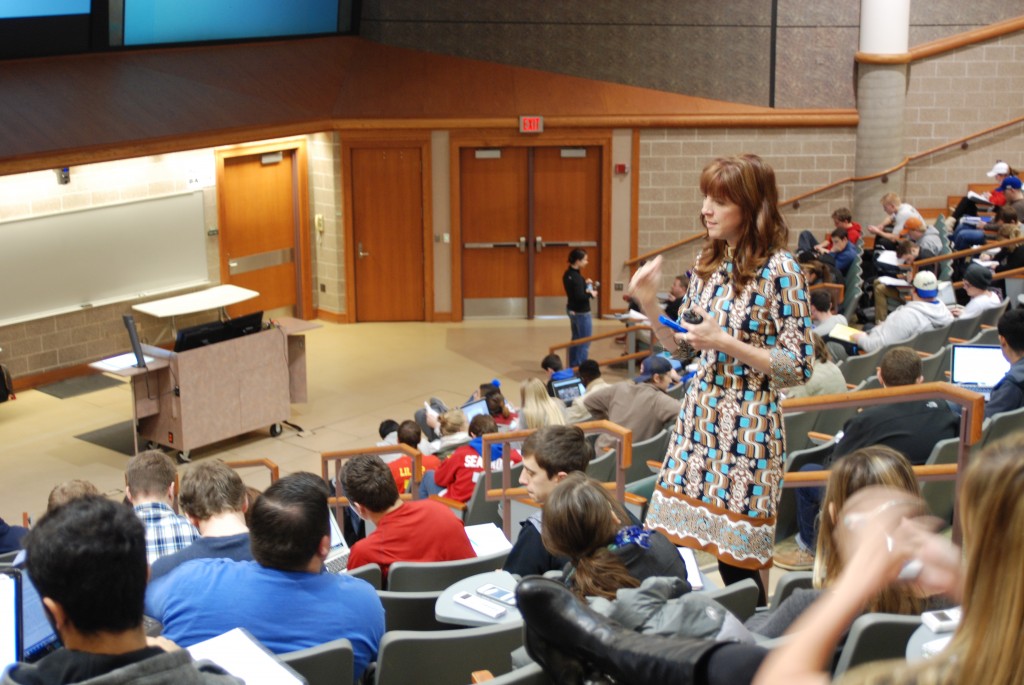
Jennifer Roberts first noticed the difference a few years ago in Geology 101.
The course regularly draws 300 or more students a semester, and Roberts, an associate professor of geology, was teaching in much the same way she had since she took over the course in 2002: lecture and exam.
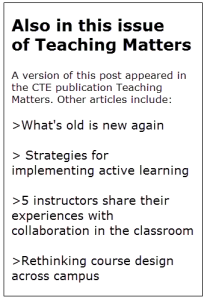
Problem was, exam scores were dropping, she said, and as she interacted with students, she found that they had less understanding of the material than students had had just two or three years before.
So Roberts set out to transform the class, which is now called The Way the Earth Works (There was a link, but it no longer exists), into an active learning format, with in-class group work, student presentations, clicker questions aimed at prompting discussions, and lots of interactions with students. With the help of Kelsey Bitting, a postdoctoral teaching fellow, she began moving away from what Bitting calls the “fire-hose approach” to teaching and concentrating on helping students learn core skills through hands-on activities.
Research has long cast doubt on the use of lecture in education. Donald Bligh, in his book What’s the Use of Lecture?, provides some of the most compelling evidence, reviewing more than 200 college-level courses in several disciplines. The biggest benefit of lecture is that it is an efficient means of reaching a large number of students in a single setting. Bligh argues that lectures can be useful in conveying information but that they do little to promote thought or problem-solving abilities, or to change behavior. Rather, they reinforce ideas, values, and habits that students have already accepted.
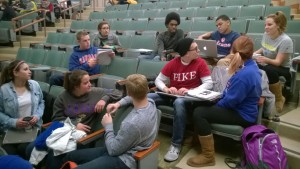
discussing ways to solve problems.
Despite the evidence about lecture’s weaknesses, two-thirds to three-quarters of faculty members continue to rely it, according to research summarized by Derek Bok of Harvard in his book Our Underachieving Colleges. As Bok argues, though, facts, theories, and concepts delivered in lecture have little value unless students can apply them to new situations, ask pertinent questions, make reasoned judgments, and arrive at meaningful conclusions.
Bitting urges instructors to think about it this way: “You may have a lecture that works to get students to take a multiple choice test really effectively,” she said. “But when you have a conversation with that student after your semester, they may not actually remember anything. Or they may not know how to make sense of it outside of the context of the little paragraph in the textbook where they read it the first time.”
Transforming a class, especially a large lecture class, isn’t easy. Roberts has essentially applied the scientific method to her teaching of Geology 101, experimenting with a variety of techniques. Some have failed; others have succeeded. “There has been a lot struggle but also self-reflection on my process and then on the learning process in general,” she said.
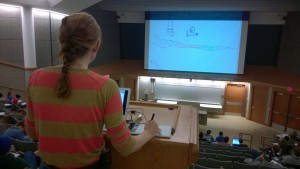
having students create their own drawings,
below right, and fill in areas that Roberts asks about.
Roberts said her experience with active learning in a large class had forced her to step away from the class material and recognize that students “are not me.”
“They don’t learn like I do,” she said. “And that’s OK. But my job is to have them learn, so I need to think about what’s the best to have everybody do the best they can and to learn.”
The adjustments in an active learning class can be difficult for students, as well. As Catherine Sloan writes in Change magazine, millennials “have a deep fear of failure,” so getting them to take intellectual risks takes patience. Nor do they deal well with ambiguity. They like clear, firm solutions to academic problems, and pushing them to think beyond a single “right answer” also takes work from instructors.
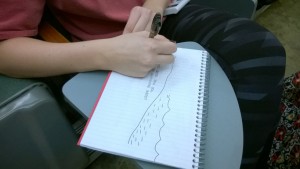
Tradition has also made changing the format of classes more challenging. Students have grown accustomed to sitting passively in lectures, reviewing instructors’ notes or slides posted online, attending study sessions (again, passively), cramming for exams, and moving on. Many resent having to take an active role in class – isn’t that the professor’s job? – and in their learning in general.
Even so, many students find the expectations of their professors lower than they had anticipated. Sloan writes that “the most common complaint we hear from students is not that their professors are too demanding but that they don’t hold firmly to deadlines and expectations.”
Bitting also urges instructors to look more broadly at student learning.
“Even if your lecture is working really well for getting your students to take a multiple choice test, if they’re not excited about it and they don’t care about it when they leave, maybe you’re not doing the job you want to do,” she said.
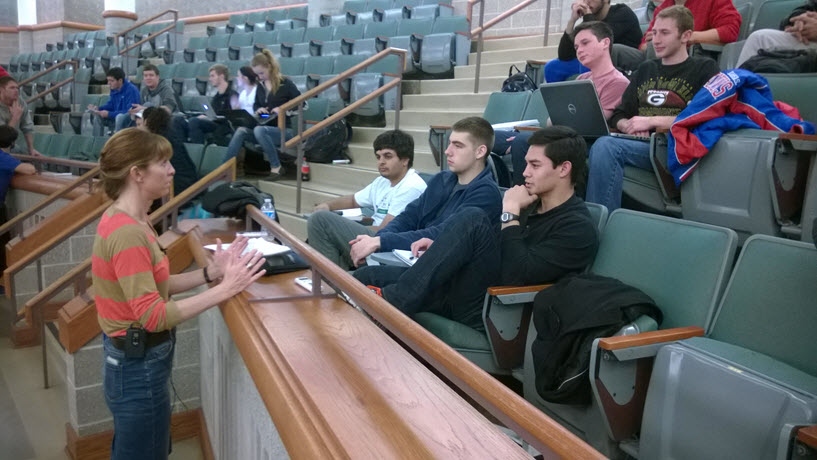
Questions and doubts about online education
In a discussion among faculty earlier this week, a conversation about online education quickly turned skeptical.
We were exploring the model of the Minerva Schools, which uses a combination of online and experiential learning with a small group of students. It aims to reduce the cost of college by using technology, rather than physical classrooms, and to create cohorts of students who live in and explore different international locations each year. Minerva’s first class of students started last fall.
One faculty member in our discussion at CTE said that her most memorable undergraduate experiences took place in hands-on labs or in field experiments where students explored the many facets of the natural universe. How is it possible to replicate that experience online? she asked.

Another faculty member talked about the difficulty of having deep discussions online. Yes, students and instructors can share thoughts and debate gray areas on a virtual discussion board, but those discussions lack spontaneity. Even live discussions with webcams don’t provide the same interactions or visual cues as in-person discussions. They also lack the same verve of classroom interaction, he said.
Those doubts are understandable. They are also widely shared.
A report released earlier this month by Babson Survey Research Group and the Online Learning Consortium (There was link here, but it no longer exists) showed a tempering of enthusiasm for online undergraduate courses. Growth in online courses has slowed considerably from a few years ago, though it is still at 3.8 percent annually. The authors of the report write:
“While the number of students taking distance courses has grown by the millions over the past decade, it has not come without considerable concerns. Faculty acceptance has lagged, concerns about student retention linger, and leaders continue to worry that online courses require more faculty effort than face-to-face instruction.”
Babson’s survey of chief academic offers found that faculty acceptance of the “value and legitimacy of online education” declined over the last two years to 28 percent, nearly the same percentage as in 2003.
The report provides a central reason that faculty members have doubts about online courses: There is “no agreed upon measure of educational quality – either for face-to-face or for online education.”
We have no common, definitive way of comparing, so we go with our gut, and our gut tells us that in-person learning is better than online learning.
I understand faculty concerns about online courses. At the same time, I see great value in those courses and see a need to continue expanding them. I’ve been leading development of a mostly online master’s degree in Digital Content Strategy that will start this year. Online courses for undergraduates provide an important means for students to keep on track toward graduation, especially during the summer and intersession. We can also use online courses to reach out to students who stopped their education at some point, giving them the opportunity to complete their college education.
One reason online education raises such doubts at traditional universities, though, is that those universities fail to explain its role in undergraduate education. At one point, administrators pushed online courses because they saw them as a way to save faculty time and universities money. (They don’t, if done right.) Or they pursued them because everyone else was, and they didn’t want to get left behind.
Beyond that, though, they haven’t addressed some crucial questions: Are universities developing online courses for student convenience? For faculty convenience? Are they intended to help improve graduation rates? To provide new ways of learning? And if they expand their online offerings, how do those courses fit with on-campus instruction? Most important, are students learning what they need to learn in whatever format courses take?
Those are just a few of the challenging questions we have to consider. Those questions loom especially large at universities that have invested millions of dollars in a physical infrastructure, that have specialized in personal interaction and hands-on learning opportunities, and that have sold students on the idea of an on-campus “experience.”
Until faculty members see a strategy to online course development, until they buy in to the why behind online course offerings, and until they alleviate valid concerns about online courses’ ability to deliver deep, meaningful learning, they will continue to express skepticism. And rightfully so.
Doug Ward is an associate professor of journalism and the associate director of the Center for Teaching Excellence. You can follow him on Twitter @kuediting.
Moving active learning beyond ‘Lady, you’re crazy’
Active learning helps students learn in deep, meaningful ways, as study (There was a link here, but the page no longer exists) after study has shown.
That doesn’t mean it’s easy. On the contrary, students who have grown accustomed to sitting through lectures with one eye on their phones and one foot out the door often rebel at changing to hands-on exercises, in-class discussion among dozens or hundreds of students, peer learning, group projects, and other techniques that force them from their seats.
Alison Olcott Marshall, who, with the help of Kelsey Bitting, a postdoctoral teaching fellow, has transformed an undergraduate paleontology class for non-majors into an active-learning format, found out first hand last semester how difficult it can be.
“The first couple of weeks were hard because they were like, ‘Lady, you’re crazy,’” Olcott Marshall said.
She persisted, though, transforming a 100-level paleontology course that had long been a “romp through all the fossil organisms that had been found” into one with a narrower focus aimed at engaging students in the scientific process. The culmination of the craziness was an event called Paleocon, a public display of group projects that students worked on in lieu of taking a final exam. The goal was to synthesize paleontological topics in a way that students and their peers could understand, Olcott Marshall said, as the video above explains.
One of Olcott Marshall’s students, Ian Rhoads, described the class as “a very guided, hands-on learning process.”
“Ms. Olcott Marshall is really good at making sure that we’re all on track,” he said.
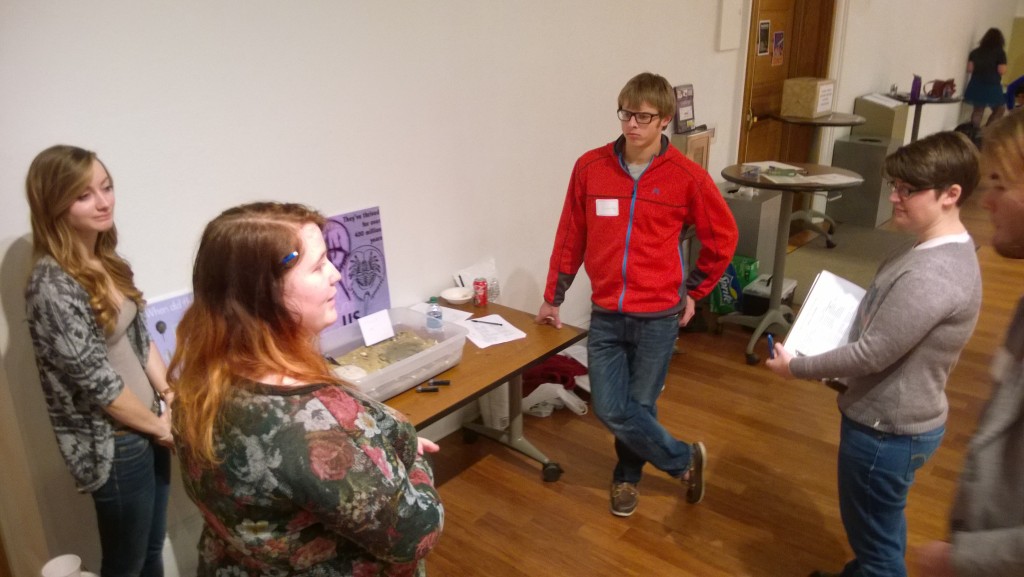
Another student, Miranda Mitchell, said she was “shocked having to be in a group and do so much group work.” She warmed to the process, though, saying, “It’s very cool to get to talk with someone every day and get to know people on a different level than you would anywhere else.”
Alex Tait, a photography major, worked in a group with a theater major (Annie Fuquay) and a business major (Wesley Riedmiller). She said the class format pushed students to take on research on their own rather than just read about it and listen to it described.
“We’re artsy kinds of people, so to this type of opportunity really motivates us to want to learn the information and apply it things that interest us as opposed to just being in the library and studying and then going and taking a test,” she said.
Olcott Marshall saw the results, as well. As she walked amid the dozen or so student displays at Paleocon, she and her students were clearly energized. Pushing through the students’ skepticism about this crazy active learning approach had clearly paid off.
“Now they’re like, ‘Oh, this makes sense. I see why I had to work,’ ” Olcott Marshall said.
Education Matters: Unconventional learning
Earlier this week, I wrote about the unlikelihood of competition and cultural forces pushing higher education to “unbundle” its degrees and services.
Jeff Young of The Chronicle of Higher Education provides yet another take on that notion. Young says that providers of massive open online courses, or MOOCs, have pledged to democratize education, allowing anyone to become an educator and a learner. He describes platforms like Udemy, edX and MOOC.org collectively as the “sharing economy meets education.”
In one example, a 25-year-old entrepreneur with no teaching experience has made tens of thousands of dollars through his app-building course on Udemy. An Iowa State professor makes $2,500 a month from a collection of online courses he calls the Critical Thinker Academy, and aspires to work on that full time.

As Young explains, there’s a growing audience for learning among motivated people who have degrees (or not) and want to keep learning but don’t want to pursue another degree. These people aren’t afraid to step outside the traditional realm of education.
“The bigger, more immediate threat to colleges is indirect,” Young writes. “These sites that let anyone teach courses might just change the way people think about the value of education, about the nature of expertise, and about what teaching is worth.”
There are no surprises here. This is just part of a much longer conversation on the role and value of MOOCs and the future of higher education. It is yet another sign of the need for colleges and universities to change, though, and another reminder of the opportunities for those institutions that can effect that change.
More unconventional learning
While we’re on the topic of unconventional approaches to learning, I’d recommend reading Jessica Lahey’s Atlantic article “What Teachers Can Learn From Vsauce’s YouTube Show.”
Lahey profiles Michael Stevens, host of a high-energy YouTube education channel called Vsauce. Stevens takes on such quirky topics as “Is Cereal Soup?” and “What If the Earth Stopped Spinning?” and (shudder) “What Does Human Taste Like?” She writes:
Stevens understands that the best teachers don’t just hurl vast shovelfuls of wisdom at their students, hoping some of it sticks as it whizzes by. Great teachers know that education is a long game, and much of the time, the lesson at hand is not the final destination but an opportunity to contextualize and support future learning.
Stevens’s ability to connect with audiences – his 10-minute videos get millions of views each – goes beyond great titles, pun-filled presentations and sharp visuals, though. Lahey writes:
You don’t learn from a Vsauce video because you put out a lot of effort to do so; you learn because Stevens makes the information matter.
That, perhaps more than anything, is what those of us in higher education need to take away from the popularity of Vsauce, Udemy and other unconventional forms of education: We have to make information matter. We have to make learning matter. We have to make education matter. We have to help students see the connections among the topics we teach, and among the topics our colleagues teach.
That ability to connect – with students and among topics – is a central component of the future of education.
Generate! Blah-blah-blah. Repeat! Blah-blah-blah.
In a post last month, I wrote about Audrey Watters’s list of vapid academic jargon and her prediction that the blah-blah-blah would continue unabated in 2015.
Since then, I’ve run across a wonderful tool called the Jargon Generator, which was created by Andy Allan, a high school teacher in California who maintains a site called ScienceGeek.net.
Allan says he was inspired to create the Jargon Generator after reading new guidelines for AP Chemistry. The generator was modeled on a similar tool on Dack.com.
The Jargon Generator is a must-see amusement for anyone who has slogged through a poorly edited academic journal, suffered through a grant application, endured an administrative meeting or survived a speech by an educational consultant. Just push the “Generate jargon!” button and see such amazing empty phrases as these:
- We will visualize school-based pedagogy across content areas.
- We will aggregate shared differentiated lessons within professional learning communities.
- We will cultivate shared concept maps across cognitive and affective domains.
For even more fun, try an active learning experiment and string together some of the sentences on your own:
We will discern bottom-up paradoxes with a laser-like focus, ultimately integrating synergistic technologies within the new paradigm. We fully expect that to agendize college and career ready interfaces within professional learning communities and operationalize diverse stakeholders for high-performing seats.
My only complaint with the Jargon Generator is that all the sentences it creates are in active voice. True jargon is dipped from a cesspool of passive:
Bottom-up paradoxes will be discerned with a laser-like focus, and the new paradigm will ultimately be integrated with synergistic technologies. College and career ready interfaces within professional learning communities are expected to be fully agendized upon the operationalization by diverse stakeholders for high-performing seats.
If that doesn’t make you want to run for the exits, you’ve no doubt been reading too much of the Journal of Cooperative Paradigm Processes for 21st-Century Learners. You have my sympathy.
Higher education isn’t breaking apart, but it is vulnerable
Will students one day piece together their own degrees by assembling courses a la carte from a variety of colleges and universities?
Derek Newton of the Center for Teaching Entrepreneurship, says no. Writing in The Atlantic, Newton argues that technology won’t force the “unbundling” of degrees and programs in higher education the way it has the music industry and cable TV.
The American Enterprise Institute, among others, contends that technology indeed will force higher education to change its existing model of “bundled services” like degrees, dorms, food services, recreation centers and the whole idea of a “college experience.” Rising costs already force most families to choose colleges based on price, making institutions vulnerable to outside competitors that can find ways of reducing costs while still providing the desired services, according to this reasoning.
The music industry and cable television have long relied on a bundling model. Songs are bundled into albums, which can be sold at higher prices; programs are bundled into expensive cable packages. Apple, among others, forced music companies to allow consumers to buy individual songs, and services like Hulu have given viewers control over when and how they watch TV programs and movies.

Newton agrees that higher education has not kept up with technology. He says, though, that a widespread breakup of higher education’s courses and services simply won’t happen. That’s because students and parents look at higher education in an entirely different way than they look at media, he says. “They shop for schools, not for professors,” Newton writes.
Newton offers a good counterargument to the idea of unbundling. What he overlooks, though, is that once students begin their education, they do indeed shop for professors. Word of mouth and sites like Rate My Professor point students toward some classes and instructors and away from others. Similarly, many students take online classes at other colleges and universities to save money or to avoid in-person classes they see as onerous. (University administrators refer to this as “leakage.”)
Students make choices about higher education based on the reputation of individual programs within a university, as well as a university’s overall reputation. They haven’t shown interest in abandoning college or university identity for a generic major, though, as in patching together a degree on their own from dozens of individual classes at dozens of universities.
Colleges and universities are indeed vulnerable, though, if they don’t prove their worth to students and parents. That must start by putting a greater emphasis on student learning and helping students see the value of courses, programs and degrees, and then move more quickly into a variety of areas:
- Course options that break away from the three-hour, in-your-seat lecture.
- An emphasis on critical thinking and adaptation of ideas instead of memorized facts.
- Clear explanations about why individual courses and topics matter and how they fit into a degree.
- Incentives for and recognition of innovative teaching.
- Approaches in which universities unbundle – yes, unbundle – their own degrees and then rebundle them into smaller packages like certificates that recognize achievements in learning but that don’t require dozens or hundreds of hours of course time.
That’s just a start. Newton is right that a great unbundling is unlikely to occur anytime soon. Critics are right, too, in that universities must change – soon.
Steps in the right direction
Diana Stepner of the education services company Pearson has declared 2015 “the year of the learner,” arguing that “the future of education will be created by learners themselves.”
That’s great news if we can help make it happen. Writing in Wired magazine (There was a link, but the page no longer exists), Stepner describes a world in which engaged students take an active role in their learning, help shape educational programs, and delve into learning with gusto.
I’m not buying into the “year of the learner” hype, but Stepner makes good points about the future of education. I see no signs that we are on the cusp of a dramatic, immediate change, but education is – and must continue – taking incremental steps to make education more learner-centered. (See above.)
Briefly …
An analysis by The Chronicle of Higher Education finds that enrollment of international students has soared at public colleges and universities in the U.S. but that those students are not taking spots that would have gone to in-state students. …. Writing in Educause, Holly E. Morris and Greg Warman offer ideas on how higher education might use design thinking. … Writing in Good magazine (There was a link, but the page no longer exists), Rosie Spinks says that “libraries in the world’s major cities seem poised for a comeback, though it’s one that has very little to do with books.”
Ambiguity goes in search of the right answer
The note cards I handed out to students in my hybrid class last week drew astonished looks.
Each contained a hand-written list of three things: events, people, animals, objects, locations, movies, songs, television shows. All were random, created one evening in a stream of consciousness. For instance:
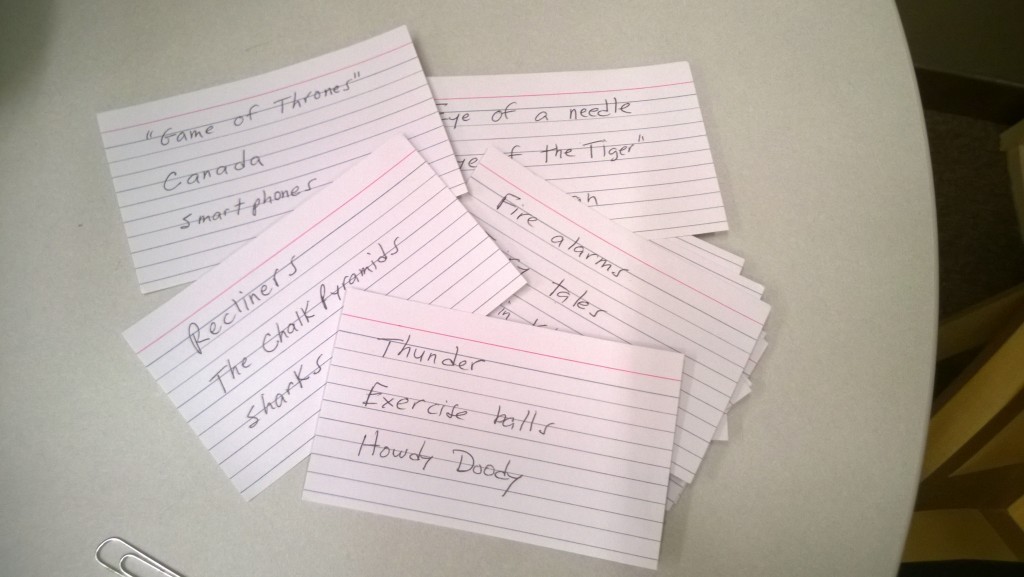
“Eye of the Tiger”
Eye of a needle
Arctic Ocean
and
Fire alarms
Fairy tales
Calvin Klein
“Here’s the fun part,” I told students. “Find a connection among the three things.”
That’s where the astonishment came in.
The main goal of the exercise was to help students synthesize, to open their eyes to connections they might not otherwise see and to creative solutions they might not otherwise consider. They worked in pairs, and once they got beyond the initial “I can’t do this” shock, they generally came up with excellent answers.
After the exercise, one student asked a question that surprised me, even though it shouldn’t have.
“What’s the right answer?” she asked.
After wincing, I said there was no right answer to any of the postcard triads. Then I recited one of my educational mantras to all the students:
“There are no right answers in this class,” I said. “There are better answers. But there are no right answers.”
That’s a hard concept to grasp for students who focus far too much on a grade and a diploma rather than on learning. Ambiguity and uncertainty make them uncomfortable, and many have been taught that there are indeed right answers in their classes.
In some disciplines there are, of course, though even in those the understanding of the process is more important than any single answer.
I teach a class called Infomania, which is intended to help students become better researchers and to help them learn to solve problems with information and digital tools. I also try to help students work their way through ambiguity. Pushing them to find a link between fire alarms, fairy tales and Calvin Klein is part of that. So is working in groups, developing individual and group projects, and other approaches that emphasize active learning.
I thought about sharing some of the students’ creative responses to my nonsensical challenge but decided that wouldn’t be fair. You, dear reader, must work through that ambiguity on your own.
Remember, there are no right answers.
Education Matters: Confusion, opportunities and predictions
Teachers and administrators say they want to see more innovation in teaching but blame each other for creating obstacles to experimentation, The Hechinger Report writes.
In the article, Jordan Shapiro says that lack of a “dependable shared language” may contribute to the problem. Education buzzwords abound, but clear definitions of those buzzwords are in shorter supply (see Audrey Watters below). That makes it harder to gauge what administrators want or what teachers are doing, Shapiro says.
Colleges and universities have additional problems when it comes to innovative teaching. In some cases, neither administrators nor instructors see much value in pursuing changes in teaching, making it easy to point a finger at someone else while continuing on the same easy but ultimately directionless path. A lack of recognition of and rewards for innovative and effective teaching further hinders change. And I agree with Shapiro that we need to do a better job of explaining what we mean by innovation and effective teaching.
One way to bring about change is to reach out to faculty and administrators who do value teaching, creating a community that demonstrates ways to improve teaching and learning, and helps others take small but meaningful steps toward change. That approach has worked well at the Center for Teaching Excellence with such efforts as the Best Practices Institute and the C21 Consortium, along with our annual teaching summit and periodic workshops and discussions.
Those and other events have generated new ideas for improving student engagement and student learning, promoting reflective teaching, and spreading the word that change is indeed possible from within.
Predictions for 2015 and beyond
Predictions abound at the beginning of every year. Among the publications, organizations and blogs I follow, here are some of the predictions that stood out:
- More state regulation of higher education. (Forbes)
- Increased support for competency-based education programs. (eCampus News)
- Increased pressure from students for college to be “faster, cheaper and more customizable.” (eCampus News)
- Growth of adaptive, personalized learning, and “just-in-time knowledge.” (University Business)
- Possible plateauing of online education. (e-Literate)
- Continued growth in a bring-your-own-device approach to technology, personalized learning, and the use of tablets in K-12 education. (The Journal)
- More attention on student behavior at college campuses. (NPR)
- More of the same empty buzzwords: MOOCs, cloud, big data, social, disruptive innovation, blended learning, personalized learning, efficiency, game-changers, learning outcomes, blah, blah, blah. (Audrey Watters)
Briefly …
Tuition from students now accounts for more revenue than state financing at public colleges and universities in the United States, USA Today reports (There was a link, but the page no longer exists), citing a report from the Government Accountability Office. … The Chronicle of Higher Education has released A Guide to the Flipped Classroom (There was a link, but the page no longer exists), a downloadable booklet that includes seven articles from the Chronicle, along with a short list of resources. Download requires a name, title and email address.
Doug Ward is an associate professor of journalism and the associate director of the Center for Teaching Excellence. You can follow him on Twitter @kuediting.